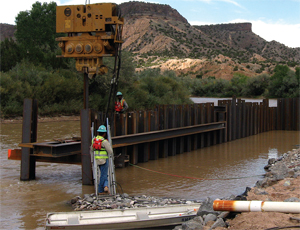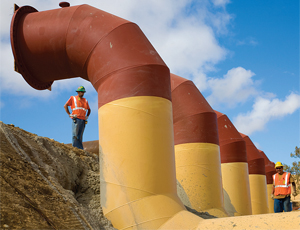The economic downturn has provided a good climate for the rare water utility that has available cash. Potential bidders are crowding pre-bid meetings, materials prices have fallen steeply, and many bid prices have dropped 15% to 40% below engineering estimates. “If you’re an owner, it’s a good environment for bidding,” says John Boisvert, chief engineer with Pennichuck Water Works, an investor-owned water utility in New Hampshire.


“It’s been a wonderful bidding climate to get projects done,” says Neil Goldfine, executive director of the Atlantic City (N.J.)Municipal Utilities Authority, which has been able to expand planned projects through stimulus funds and good bid prices.
But despite the lower prices and $6 billion from the American Recovery and Reinvestment Act for water and wastewater projects, utilities are grappling with how to pay for the multibillion-dollar bill to replace much of the nation’s nearly century-old water distribution system.
Most water pipes in the U.S. were installed at the end of the 1800s, in the 1920s or after World War II. “It’s an unhappy coincidence that all are ending their useful life within the same time frame,” says Greg Kail, a spokesman for Denver-based American Water Works Association.
Some cities are forecasting triple-digit rate increases to pay for expected system improvements needed over the next 20 years. Some water providers in the San Francisco area already are raising rates to pay for the nation’s largest ongoing water project: $4.6 billion in system improvements to update and strengthen the region’s 167-mile, 100-year-old drinking-water system. The city is ahead of the rest of the nation in replacing its aging system because of its vulnerability to earthquakes.
“If we did not have that motivation, we might try to keep patching the old system,” says Julie Labonte, program manager for the water-system program at the San Francisco Public Utilities Commission.
According to a U.S. Environmental Protection Agency needs assessment released to Congress in February, the nation’s drinking-water systems need $335 billion invested over the next 20 years. Various estimates peg the combined need for drinking-water and wastewater projects over that time at between $500 billion and $1 trillion.
“The economy hasn’t slowed the need for water or wastewater projects,” says Rich Henning, a senior vice president for Harrington Park, N.J.-based United Water, which operates 240 municipal water systems throughout the nation. “It’s a need whose time must come.”
ARRA made a slight dent in the need, jump-starting dozens of projects that lacked funding because of poor credit markets and a weak economy. Through state revolving funds, the American Recovery and Reinvestment Act provided $2 billion for drinking water projects and $4 billion for clean water projects.
“The stimulus money has helped states begin authorized projects that could have been frozen,” says Steve Johnson, senior vice president of AECOM Technology Corp., Los Angeles.
According to EPA, at the end of September 143 drinking water projects, totaling $169 million, and 180 wastewater projects, totaling $463 million, were under construction using ARRA money.
Full Speed Ahead
Utilities slated to get stimulus money are ecstatic that once-languishing projects are now nearing or under construction.
“We were putting [projects] in the delay column for right now, potentially delaying them until 2011. They were all...

Post a comment to this article
Report Abusive Comment